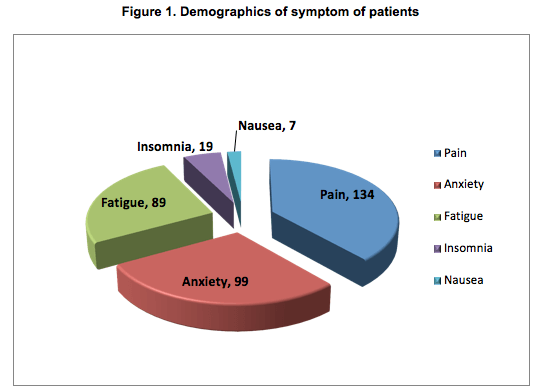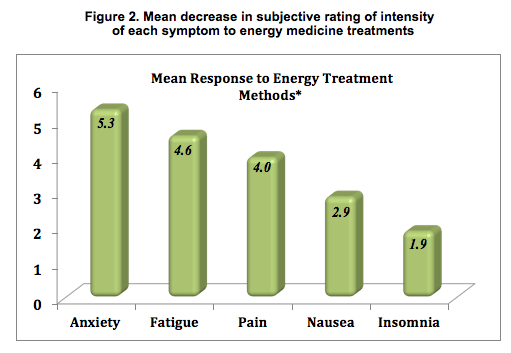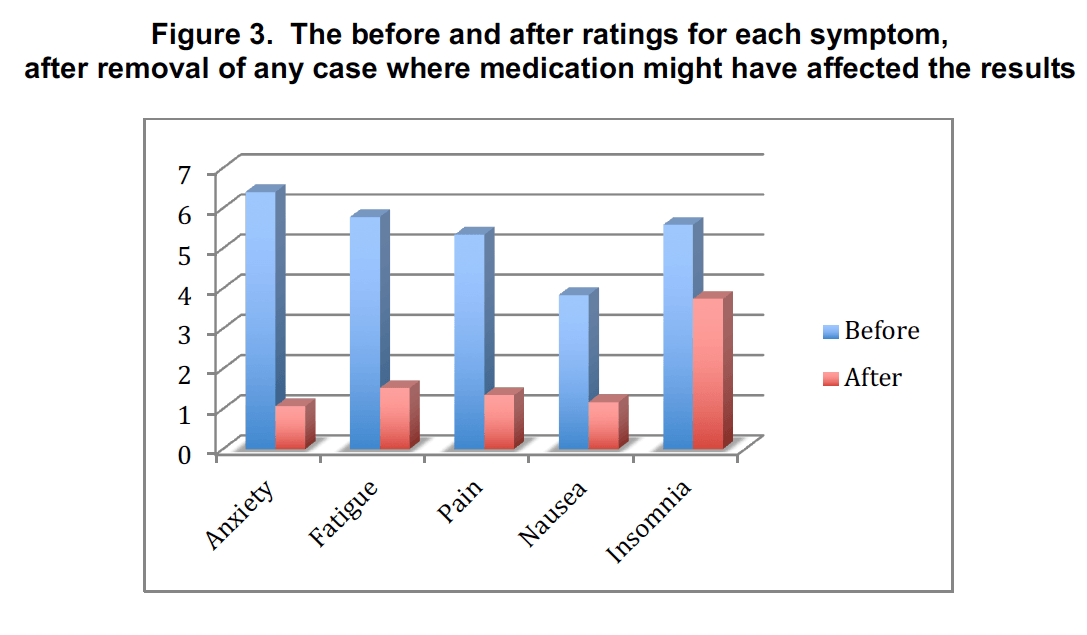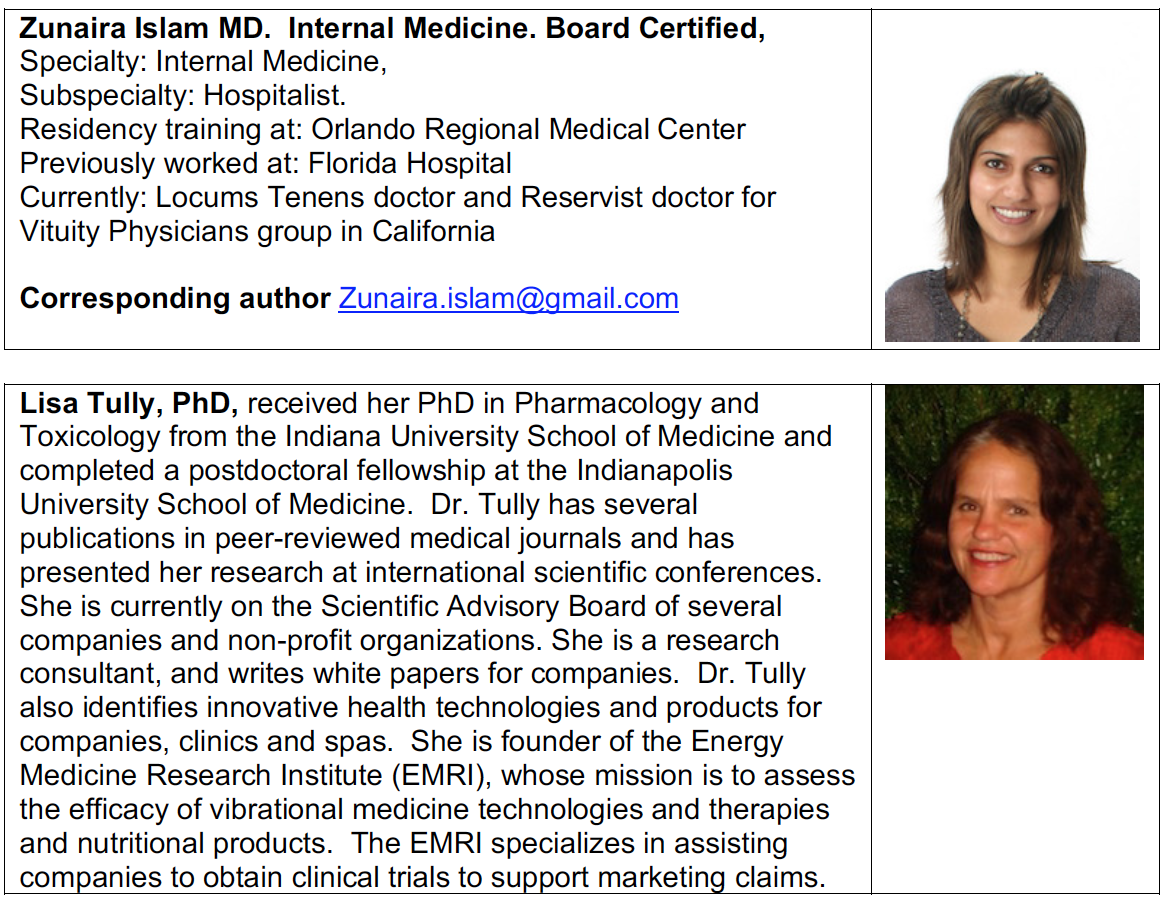Abstract
Energy medicine techniques, including Healing Touch, Reiki, Quantum Touch, Donna Eden Method were added to the routine medical treatment regime of cancer patients at the MD Anderson Cancer and their effects were evaluated on the most common symptoms suffered by the patients, including anxiety, pain, fatigue, nausea and insomnia.
Improvements ranging from 3.4-5.8 points (on a scale of 1-10) were seen in symptoms, as rated by the patients and these were highly significant. The highest response was found in anxiety (CI 4.7-5.8), followed by pain (CI 3.4-4.5) and fatigue (CI 3.6-4.8). Our results demonstrate that energy medicine techniques provide significant symptomatic relief, as judged subjectively by the patients. Furthermore, our results indicate that energy medicine techniques can be non- pharmaceutical adjuncts in helping to control the symptoms of cancer patients, many of whom are already on multiple medications.
Introduction
Energy healing therapy is a form of complementary and alternative medicine (CAM) recognized by NCCAM (National Center for Complementary and Alternative Medicine). It pertains to a group of similar but unique methods such as Healing Touch, Therapeutic Touch, Quantum Touch, Traditional Chinese Medicine, Reiki, Pranic Healing and others.
These energy medicine techniques have been used to treat a wide range of physical conditions, including pain (Jain et al. (1999), Cordes, et. al. (2008), Ciuffreda et. al. (2012), Thrane, and Cohen, (2011) and Tully (2017), orthopedic concerns (Dinucci (2005), burns (Turner, et. al. (1998), insomnia (Yong Chen (2007), in supportive nursing (Anne Vitale (2006) and have been embraced by medical and nursing practitioners (Benor (2002).
Some of these methods have been used to treat the symptoms of cancer (Conella et. al., 2014; Wong et.al., 2001; Yates et. al., 2001), pain (Anderson and Taylor, 2012), anxiety, (Mansky, et.al., 2006), fatigue, (Tsang et. al., 2007), nausea, (Pierce, 2007) and insomnia (Yong Chen et. al., 2005).
Most of these therapies are considered to work on meridians, energy centers, chakras and trapped emotional energy in the body. There is a growing interest in these practices in the US. They are considered by many to be beneficial emotionally and spiritually, as well. It is also reported to be free of harmful side effects, making it a supplemental treatment that many are willing to try.
The hypothesis of this study is that energy healing therapies have a beneficial effect for managing common symptoms of cancer patients, including pain, anxiety, fatigue, nausea, and insomnia. This research project was conceived by Dr. Islam as part of fulfillment of her residency at University of Central Florida Medical School Orlando. She designed a study of the efficacy of energy techniques on the symptoms commonly reported by cancer patients at the Mind/Body/Medicine Integrative Medicine Center in Orlando. During that time, the Mind-Body Center at MD Anderson Cancer Center in Orlando provided complementary sessions of energy healing therapy for cancer patients for several years . The sessions were provided by a group of certified practitioners who volunteered their time regularly to help alleviate the cancer patients symptoms. They were certified in the Donna Eden Method, Reiki, Healing Touch and Quantum Touch.
Methods
The open clinical study was designed to evaluate the effects of energy medicine techniques on symptoms commonly suffered by cancer patients, in addition to their routine medical treatment regime at the MD Anderson Mind/Body/Medicine Integrative Medicine Center in Orlando.
Subjects were recruited by word of mouth by Jean Miller Clark (Board Certified Chaplain and Manager of the Mind Body Medicine Program) and the nurses of the Mind Body Medicine Center in- and out-patient departments. A minority of the subjects were admitted in adjoining Orlando Regional Medical Center. Most of these had a cancer diagnosis or were being tested for cancer. The age of the participants ranged from 17-82 with a mean age of 53 years. There were 152 females and 19 males.
For the study, participants were de-identified, then asked to use a ten-point scale to subjectively rate the symptoms they were feeling (with one being the lowest and ten being the highest in intensity). They rated their symptoms before a session of energy therapy and immediately after it was over. The most common symptoms reported by the patients were pain, anxiety, fatigue, nausea, and insomnia and these were evaluated. They also were asked to leave comments on the questionnaire.
A total of 171 energy healing sessions were studied on 94 patients between 2010 and 2011. The patients were either in-patients or scheduled out-patients with no reported major changes to their home drug regimen. Patients received the sessions in a dedicated energy-healing room.
Each session was counted as one case study, even when multiple symptoms were treated. This was done to simplify the project, as many patients had multiple symptoms and it was not possible to get them to return to test one symptom. The main focus of the study was to assess whether energy medicine techniques improve subjectively rated patient symptoms. There were 77 participants who had more than one session. Symptoms were studied using the difference in the before and after rating and the mean of the difference was reported in each session.
To examine confounding bias caused by medication use, all cases where medications could possibly be a confounding variable, based on the medicines half-life and time-for-peak-effect, were excluded from the final result. Many out-patient cancer patients were on prescription drugs for pain; 42 in- and out-patients were on prescription drugs for anxiety; and 38 patients (in and out-patients) were on prescription drugs for nausea. The nurse records for each patient were accessed and the cases where any drug for the above symptoms, intravenous or per-oral had been given up to 4 hours before the session were excluded from the final result. Also excluded were any cases where a new long-acting pain-medication had been started on an in- patient and given up to 5 hours prior to the session. This was done based on half-lives and time-to-peak effect of the common long-acting pain medications to prevent an influence of the patient medications on the results.
Results
Figure 1 shows the number of patients with each symptom. Pain had the highest incidence (134 patients), followed by anxiety (99 patients), fatigue (89 patients), insomnia (19 patients) and nausea (7 patients).
Figure 2 shows the mean response of each symptom to energy medicine treatments, in order of effectiveness, as rated by the patients on the 1-10 scale. As seen, anxiety exhibited the largest mean response (5.3) followed by fatigue (4.6), pain (4.0), nausea (2.9), and insomnia (1.9).
An overall positive response was seen to energy healing sessions, with the averaged results ranging from 1.9-5.3. The significance of the results was confirmed with paired T tests showing
p-values of < 0.001 and < 0.05 and confidence intervals (described for each symptom below). Before and after results of each symptom are shown in Figure 3. The largest mean change was seen with the symptom of anxiety, followed by fatigue and pain.
Pain
A total of 134 energy medicine sessions were provided for pain. Of these, there were 15 occasions where pharmaceutical pain medication had been given prior to the study. These 15 cases were removed and the remaining 119 patients were used for our study. The average decrease in rating of pain was 4.0 points with p < 0.001 and CI: 3.46 4.53.
Anxiety
A total of 99 energy medicine sessions treated anxiety. Of these, 1 case had received anti- anxiety medication up to five hours prior to the session. This case was removed and the remaining cases counted. The average decrease in ratings for anxiety was 5.3 with p < 0.001, CI: 4.78 5.89.
Fatigue
A total of 89 energy medicine sessions treated fatigue and no pharmaceutical medication had been given to them for this symptom prior to their session, so 89 cases were counted. The average decrease in rating of fatigue was 4.3 with p < 0.001 and confidence interval CI 3.69 – 4.82.
Insomnia
A total of 19 sessions were provided for the symptom of chronic insomnia/inability to rest. Nurse records showed that none of these patients had received sleep medication prior to their session. An average decrease of 2.9 was noted in their rating, with a p < 0.05.
Nausea
A total of 7 sessions were provided for nausea. Of these one had received nausea medication prior to their session. After removing this case, an average decrease in rating of 1.8 was noted for nausea. Sample size is too small to confidently study this subject with a paired-t test. The results for all symptoms are shown in Figure 3, after removing any results from patients who took medications.
Conclusions
Our results demonstrate that energy medicine techniques provide a significant relief of anxiety, fatigue, pain and insomnia symptoms in cancer patients, when judged subjectively by the patients. Results show that the symptom of anxiety had the best response to energy therapy, with a mean decrease in anxiety levels of 5.3 points. The next symptom most likely to benefit was fatigue, with a mean decrease of 4.3 points. Pain was the most common symptom treated but had the third most significant decrease of 4.0 points.
In conclusion, energy healing therapies may be useful for health-care providers in helping to control the common symptoms of their cancer patients, many of whom are on multiple medications already. It can be used as a non-pharmaceutical and effective means to treat their anxiety, fatigue, pain and insomnia. Energy medicine therapies provide an extra advantage, which is that they have no known side effects.
Acknowledgments:
- Jean Miller Clark: Board Certified Chaplain and former Manager of the and former Manager of of Mind-Body Medicine department at MD Anderson Cancer Center Orlando
- Veronica Schimp DO: Mentor and Supervisor. OBGYN Oncology. MD Anderson Cancer Center Orlando.
References
Anderson J.G. and Taylor A.G. (2012). Biofield therapies and cancer pain. Clin. J. Oncol. Nurs. 16(1), 43-8.
Daniel J Benor (2002) Energy Medicine for the Internist. International Journal of Healing and Caring. 86(1), 105-125.
Ciuffreda, L., Birocco, N., Guillame, C., Storto, S., Ritorto, G., Catino, C., Gir., N., Tealdi, G., Orecchia, C., De Vito, G., M., Giaretto, L., Donadio, M.,
Bertetto, O., Schena, M. and Cuifreddo, L. (2011) The Effects of Reiki Therapy on Pain and Anxiety in Patients Attending a Day Oncology and Infusion Services Unit. Amer. J of hospice and Palliative Med. 29 (4), 290-294.
Cordes C., Proffitt C., Roth J. (2008) The effect of healing touch therapy on the pain and joint mobility experienced by patients with total knee replacement. Healing touch International Research Survey. 9th Edition. Healing Touch International, 49-50. Dinucci E.D. (2005) Energy Healing- A complimentary treatment for orthopedic and other conditions. Orthopedic Nursing. 24(4), 259-269.
Frank L.S., Frank J.L. March D.., Makari-Judson G.L. (2007) Does therapeutic touch ease the discomfort or distress of patients undergoing stereotactic breast core biopsy? A Randomized clinical trial. Pain Medicine. 2007 8(6), 419-424.
Gonella S., Garrino L. and Dimonte V. (2014) Biofield therapies and cancer-related symptoms-A Review. Clinical J. of Oncology Nursing, 18(8), 568-76
Jain, A. Nagarathna, Rajendra, R. and Telles, S. (1999) Effect of pranic healing in chronic musculoskeletal pain a single blind control study. International journal of alternative and complimentary medicine, 17(8).
Mansky, P. J. and Wallerstedt, D. B. (2006) Complementary Medicine in Palliative Care and Cancer Symptom Management. The Cancer Journal, (12) 5, 425431.
Pierce, B. (2007) . The use of bio-field therapies in cancer care. Clinical Journal of Oncology Nursing. 11(2), 253 -8.Thrane, S. and Cohen, S. M. (2014) Effect of Reiki Therapy on Pain and Anxiety in Adults: An In- Depth Literature Review of Randomized Trials with Effect Size Calculations. Pain Management Nursing, 15 (4), 897-908.
Tsang, K. L., Carlson, L. E., Olson, K. (2007) Pilot Crossover Trial of Reiki Versus Rest for Treating Cancer-Related Fatigue. Integrative Cancer Therapies, 6 (1), 25-35.
Tully, L (2017) Quantum-Touch Significantly Reduces Acute and Chronic Pain in Healthy Adults. J. of Healing and Caring, Vol 17 (9), 1-8.
Turner, J. G., Clark A. J., Guathir D. K., Williams M. (2008) The effect of therapeutic touch on anxiety and pain in burn patients. The Journal of Advanced Nursing. 28 (1), 10-20
Vitale, A.T. (2006) – The use of selective energy modalities as supportive nursing interventions. Holistic Nursing Practice, 20 (4), 1911969.
Yates J., Nustian, K. M., Morrow, G. R., Gillies, L. J., Padmanaban, D., Atkins, J., N., Issell, B., Dirshener, J. J., Chen, Y. (2005) Prevalence of complementary and alternative medicine use in cancer patients during treatment. Supportive Care in Cancer. 13 (10), 806811.
Yong Chen, H., Shi, Y., Sun Ng, C., Chan, S. M., Lam, Y., KK, Zhang, QL (2007)
Auricular Acupuncture Treatment for Insomnia: A Systematic Review. J. Alt and Comp. Med. 13 (6),
Wong, J. R., Sagar, C. M., Sagar, S. M. (2001) Integration of Chinese medicine into supportive cancer care: A modern role for an ancient tradition Cancer Treatment Reviews 27 (4), 235-246.
Acknowledgments
Jean Miller Clark: Chaplain and former head of Mind-Body Medicine department at MD Anderson Cancer Center Orlando ACKNOWLEDGING FOR WHAT?
Veronica Schimp DO: Mentor and Supervisor. OBGYN Oncology. MD Anderson Cancer Center Orlando. ACKNOWLEDGING FOR WHAT?
Mind-Body Center at MD Anderson Cancer Center in Orlando
(( https://www.mdanderson.org/patients-family/diagnosis-treatment/care-centersclinics/ integrative-medicine-center/clinical-services.html )



